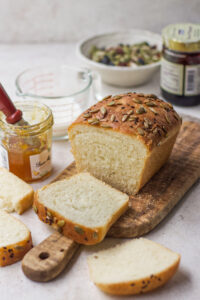I’ve always been a huge fan of suji bread—its soft texture and slightly nutty flavor make it irresistible. Recently, I decided to try making it in a cooker instead of the oven. As the bread baked in the cooker, my kitchen filled with an irresistible, nutty aroma that made the wait even more exciting. The result exceeded my expectations! The bread turned out perfectly, with a beautiful rise and a golden crust. It’s incredibly satisfying to enjoy a homemade loaf that captures everything I love about suji bread.

WHAT YOU’LL LOVE ABOUT THIS
- Eggless
- No fancy ingredient required
- No oven necessary
- Best suji bread recipe
- Simple process

INGREDIENTS USED IN MAKING NO OVEN SUJI BREAD
SEMOLINA
Semolina is a type of flour made from durum wheat. It has a coarse texture and is commonly used in savouries and bread making. In Suji bread, semolina adds a unique flavor, texture, and nutritional profile to the loaf. Always use ground semolina or grind it in a mixer grinder so that it blends seamlessly into the bread dough, resulting in a smooth and cohesive mixture. This step allows you to fully enjoy the flavor and nutritional benefits of semolina in your homemade Suji bread.
It has a distinct nutty flavor that adds depth to the bread. When incorporated into the dough, it imparts a subtle earthiness and sweetness that complement the other ingredients.
YEAST
Instant yeast is responsible for leavening the bread dough, causing it to rise and expand during fermentation. As the yeast feeds on the sugars in the dough, it produces carbon dioxide gas as a by product. Unlike active dry yeast, which requires proofing in warm water before being added to the dough, instant yeast can be mixed directly into the dry ingredients. This saves time and streamlines the bread-making process, allowing for faster fermentation and proofing. Instant yeast activates more quickly and efficiently than active dry yeast, which can help speed up the rising time and shorten overall production time. Overall, instant yeast is an indispensable ingredient in whole wheat bread-making, providing efficient leavening action, faster fermentation, consistent results, and versatility in a variety of recipes.
SUGAR
While yeast primarily feeds on carbohydrates such as starches, small amounts of sugar can help kickstart the fermentation process by providing a readily available energy source. In bread-making, sugar helps to hold onto water molecules, preventing the bread from drying out too quickly and extending its shelf life. This can result in a softer and more tender crumb.
WATER
Water is the primary liquid used in bread dough, hydrating the flour and activating the yeast. Yeast cells require water to metabolize sugars and multiply, leading to the release of carbon dioxide bubbles that cause the dough to rise. Water is essential for gluten development, which gives the bread its structure and texture. Steam is released as water evaporates from the surface of the dough in the hot cooker . This steam “sets” the crust early in the baking process, allowing the bread to continue expanding and rising before the crust hardens.
MILK
Milk contains proteins and fats that can tenderize the structure of the bread, making it more delicate and less dense. This results in a softer and more enjoyable texture. I have used Nestle toned milk for this recipe. You can swatch it with any kind of milk. Bread made with milk tends to stay fresher longer than bread made with water alone. The fats and sugars in milk help to retain moisture in the bread, slowing down the staling process and extending its shelf life.
OIL
Oil helps to tenderize the crumb of the bread, making it softer and more palatable. It also helps to improve the texture of the bread by lubricating the gluten strands and preventing them from sticking together too tightly. This results in a lighter and airier crumb, with a more open and uniform structure. Oil applied to the surface of the dough before baking can help to soften the crust of the bread, resulting in a more tender and chewy texture.

EQUIPMENTS USED FOR MAKING NO OVEN SUJI BREAD
The kind of equipment you use can hugely impact the final product. So, make sure to always use the best of the equipment that is available.
Measuring Cups and Measuring Spoons. are an integral part of any baker’s kitchen and it’s very important to measure ingredients with precision.
I used a whisk and a wooden spoon to combine all the ingredients. This equipment are basics and you can find them at any shop near you. They come in handy in so many recipes.
I used an 7X4 loaf pan to make this no oven suji bread.

RELATED RECIPES FROM THE BLOG
TIPS TO MAKE NO OVEN SUJI BREAD
- If you’re using coarse semolina, consider grinding it into a finer texture using a mixer or food processor. This ensures that the semolina blends smoothly into the dough, resulting in a more cohesive mixture and a finer crumb in the finished loaf.
- Semolina absorbs more water compared to regular wheat flour. So the dough will be quite liquid in start but it will gradually get better.
- Kneading is crucial for developing gluten in the dough, which gives the bread its structure and texture. Knead the dough thoroughly for at least 10-15 minutes to ensure proper gluten development.
- Allow the baked Suji bread to cool completely on a wire rack before slicing. This resting period allows the bread’s internal moisture to redistribute evenly, resulting in a softer texture and better flavor.
- Once the bread is baked, make sure to brush it up with butter/oil to ensure it remains soft after cooling.
HOW TO BAKE IT IN THE OVEN
- Preheat oven at 190 degrees for 5-7 minutes.
- Bake the bread at 190 degrees for 25-30 mins or until the top is golden brown.

- 1+1/2 cup suji
- 1 tsp instant yeast
- 1 tbsp castor sugar
- ¼ tsp salt
- 3 tbsp milk
- ½ cup water
- 2 tbsp oil
- In a blender jar add 1+1/2 cup suji and finely grind it.
- Add suji,sugar,yeast and salt in a bowl and give it a good whisk.
- Now add in water, milk, oil and mix using a wooden spoon to form a batter.
- Let the batter rest for 10 minutes.This will ensure that semolina has absorbed all the water.
- After 10 minutes,transfer the dough onto a greased surface and knead it for around 15 minutes.
- To check if the dough is ready to proof, take small piece of dough and gently stretch it between your fingers . If the dough can be stretched thin enough and light passes through it , it means the dough is ready and it has passed the windowpane test.
- Once the dough is formed,transfer it in a large bowl greased with oil. Cover the bowl with a cloth and let it proof for 1 hour in a dark warm place or until doubled in volume.
- Knock down the dough after the first proofing.
- Roll out the dough into a rough rectangle of ½ inch thickness.Then starting from one shorter end , roll in the dough for form a log. Make sure to pinch and lock after every turn.
- Transfer this log In a greased 7X4 inch loaf pan. Let it proof for another 30 minutes or doubled in volume.
- Meanwhile take a cooker set over medium heat and spread a layer of salt in it. Place a stand in middle and preheat for 10 minutes.
- Once the dough has risen, brush some milk and sprinkle seeds on top.
- Bake the bread in the preheated cooker for 25 minutes or until the top is golden brown.
If you like my no oven Suji Bread recipe and happen to make them in your kitchen, do tag me on Instagram and share pictures with me using #Bakewithshivesh. Happy Baking!

 Hello. I'm Shivesh Bhatia, a food blogger and food stylist from Delhi, India. Welcome to Bake With Shivesh, where I'll help you create magic in your kitchens with my simple recipes.
Hello. I'm Shivesh Bhatia, a food blogger and food stylist from Delhi, India. Welcome to Bake With Shivesh, where I'll help you create magic in your kitchens with my simple recipes.
Leave a Reply